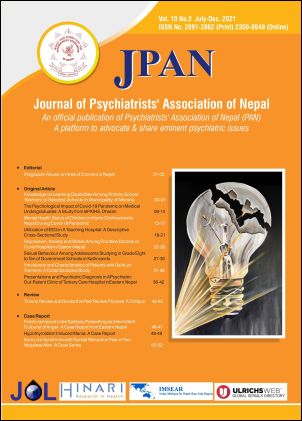Prevalence and Characteristics of Patients With Delirium Tremens: A Cross Sectional Study
DOI:
https://doi.org/10.3126/jpan.v10i2.49004Keywords:
Alcohol dependence, Withdrawal syndrome, Delirium, PrevalenceAbstract
INTRODUCTION Delirium tremens (DT) is a severe form of alcohol withdrawal with high mortality. This study aims to estimate the prevalence of DT and describe its characteristics among patients presenting with alcohol withdrawal syndrome in a tertiary care teaching hospital.
METHODOLOGY This was a descriptive cross-sectional study on the consecutive patients with alcohol withdrawal syndrome admitted in the Department of Psychiatry of a tertiary care teaching hospital in Nepal from June 2016 to May 2017. DT was diagnosed according to the International Classification of Mental and Behavioural Disorders 10. Data on the demographic characteristics, alcohol use history, and associated features were collected and analyzed with Microsoft Excel 365. The numerical variables were summarized as the median and inter-quartile range (IQR) and the categorical variables as proportion.
RESULT Of the 105 patients admitted during the study period, 73(69.52%) patients experienced DT. The majority were male (71, 97.26%), married (69, 94.52%), illiterate (28, 38.36%), and manual labourer (40, 54.79%). The median age was 42 years (IQR 34-48). The median duration of hospital stay was 11 days (IQR 8-16). The median age of commencement of alcohol consumption was 18 years (IQR 15 -20) and the duration of consumption of alcohol was 22 years (IQR 12-30). The majority consumed homemade alcohol (65, 89.04%) in a continuous pattern (66, 90.41%). The median duration of the last drink was 3 days before admission (IQR 1-8.2). Withdrawal seizure, history of complicated withdrawal, and history of DT were present in 45 (61.64%), 15 (20.55%), and 8 (10.96%) patients respectively. Medical rather than psychiatric comorbidities were more frequently observed. The most common reason for drinking alcohol was socio cultural (43, 58.90%).
CONCLUSION The prevalence of DT was high and predominantly seen in middle-aged illiterate males working as manual laborers. Homemade alcohol was consumed in a continuous pattern mostly because of socio cultural reasons. Medical comorbidities and withdrawal seizures were common.
Downloads
Downloads
Published
How to Cite
Issue
Section
License
Copyright (c) 2022 Journal of Psychiatrists' Association of Nepal

This work is licensed under a Creative Commons Attribution 4.0 International License.
This license enables reusers to distribute, remix, adapt, and build upon the material in any medium or format, so long as attribution is given to the creator. The license allows for commercial use.




